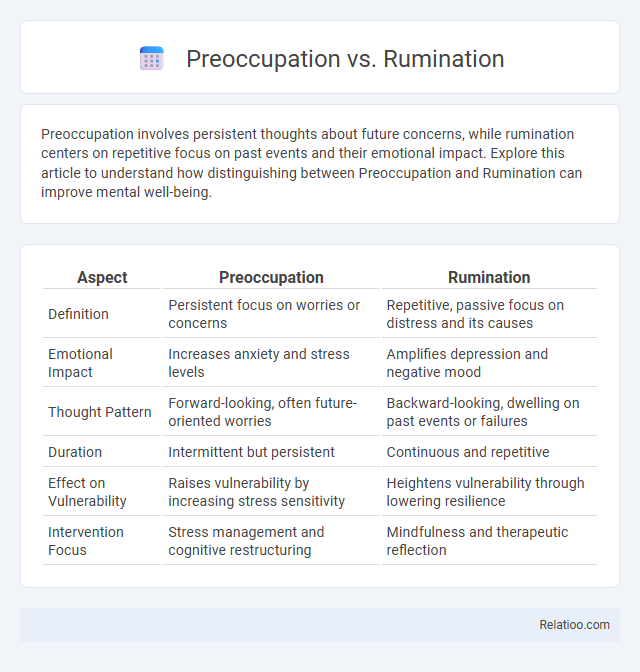Preoccupation involves persistent thoughts about future concerns, while rumination centers on repetitive focus on past events and their emotional impact. Explore this article to understand how distinguishing between Preoccupation and Rumination can improve mental well-being.
Table of Comparison
| Aspect | Preoccupation | Rumination |
|---|---|---|
| Definition | Persistent focus on worries or concerns | Repetitive, passive focus on distress and its causes |
| Emotional Impact | Increases anxiety and stress levels | Amplifies depression and negative mood |
| Thought Pattern | Forward-looking, often future-oriented worries | Backward-looking, dwelling on past events or failures |
| Duration | Intermittent but persistent | Continuous and repetitive |
| Effect on Vulnerability | Raises vulnerability by increasing stress sensitivity | Heightens vulnerability through lowering resilience |
| Intervention Focus | Stress management and cognitive restructuring | Mindfulness and therapeutic reflection |
Understanding Preoccupation and Rumination
Preoccupation involves persistent thoughts about a specific topic, often linked to daily concerns or tasks, whereas rumination focuses repetitively on distressing experiences and negative emotions, typically exacerbating anxiety or depression. Understanding preoccupation requires recognizing its adaptive role in problem-solving, while rumination is maladaptive, intensifying mental health challenges. Differentiating these cognitive processes enables targeted interventions to improve emotional regulation and mental well-being.
Defining Preoccupation: Key Characteristics
Preoccupation is characterized by persistent and automatic thoughts that occupy an individual's attention, often triggered by unresolved concerns or emotional distress. Unlike rumination, which involves repetitive and passive focus on negative feelings and problems, preoccupation includes a broader cognitive engagement with worries or future scenarios. Key characteristics of preoccupation include intrusive thoughts, difficulty shifting focus, and a preternatural absorption in specific mental content that impacts daily functioning.
Defining Rumination: What Sets It Apart
Rumination is defined as the persistent, repetitive focus on negative thoughts and feelings, distinguishing it from general preoccupation, which can involve a broad range of thoughts without an emotional bias. Unlike preoccupation, rumination specifically centers on distressing content, often linked to depression and anxiety, making it a maladaptive cognitive pattern. This contrast highlights rumination's unique role in prolonging emotional distress by fixating on problems rather than solutions.
Psychological Origins of Preoccupation
Preoccupation stems from cognitive processes involving persistent attention to specific thoughts or concerns, often rooted in unresolved psychological conflicts or stressors that demand mental resources. Unlike rumination, which is characterized by repetitive, negatively charged reflection typically linked to depressive states, preoccupation can be neutral or even problem-solving oriented but still occupies your cognitive space. Understanding the psychological origins of preoccupation involves recognizing its basis in anxiety, trauma, or unmet needs that drive ongoing mental engagement with particular issues.
The Mechanisms Behind Rumination
Rumination involves repetitive, passive focus on distress and its possible causes or consequences, often intensifying negative emotions and impairing problem-solving. Preoccupation differs as it includes persistent, pervasive thoughts that dominate attention but may not carry the same emotional valence or repetitive nature as rumination. The mechanisms behind rumination engage cognitive biases toward negative information, impaired executive control, and dysfunctional self-reflection processes that sustain maladaptive thought patterns.
Emotional Impact: Preoccupation vs Rumination
Preoccupation involves persistent thoughts about specific concerns that can distract Your attention but often remain manageable. Rumination intensifies emotional distress by repeatedly focusing on negative feelings and problems, leading to heightened anxiety or depression. Understanding these differences helps you identify when to seek strategies for emotional regulation and mental well-being.
Cognitive Patterns and Thought Processes
Preoccupation involves persistent attention to specific concerns, often disrupting daily functioning, while rumination entails repetitive, passive focus on negative emotions or problems, which amplifies distress and impairs problem-solving. Both cognitive patterns reflect maladaptive thought processes, yet preoccupation centers more on ongoing worry, whereas rumination fixates on past events or perceived failures. Understanding these distinctions can help you identify unproductive cognitive habits and develop effective strategies to improve mental clarity and emotional resilience.
Effects on Mental Health and Wellbeing
Preoccupation involves persistent thoughts about a specific concern that can mildly disrupt your daily focus but often allows for problem-solving and adaptation. Rumination, characterized by repetitive and passive focus on negative feelings and problems, intensifies anxiety and depression symptoms, severely impacting mental health and wellbeing. Distinguishing between these thought patterns helps tailor coping strategies to improve emotional resilience and cognitive clarity.
Practical Strategies for Managing Both
Effective management of preoccupation and rumination involves cognitive-behavioral techniques such as mindfulness, which promotes present-moment awareness to reduce intrusive thoughts. Structured problem-solving encourages identification and actionable responses to specific concerns, preventing repetitive negative thinking cycles. Incorporating stress management practices like deep breathing and physical activity supports emotional regulation and decreases the intensity of persistent mental focus on distressing topics.
When to Seek Professional Help
Seek professional help for preoccupation when intrusive thoughts severely disrupt daily functioning or lead to significant emotional distress. Rumination that persists for weeks, intensifies negative emotions, or contributes to anxiety and depression symptoms warrants clinical evaluation. Persistent preoccupation coupled with inability to control thought patterns despite self-help efforts indicates the need for mental health intervention.

Infographic: Preoccupation vs Rumination
 relatioo.com
relatioo.com